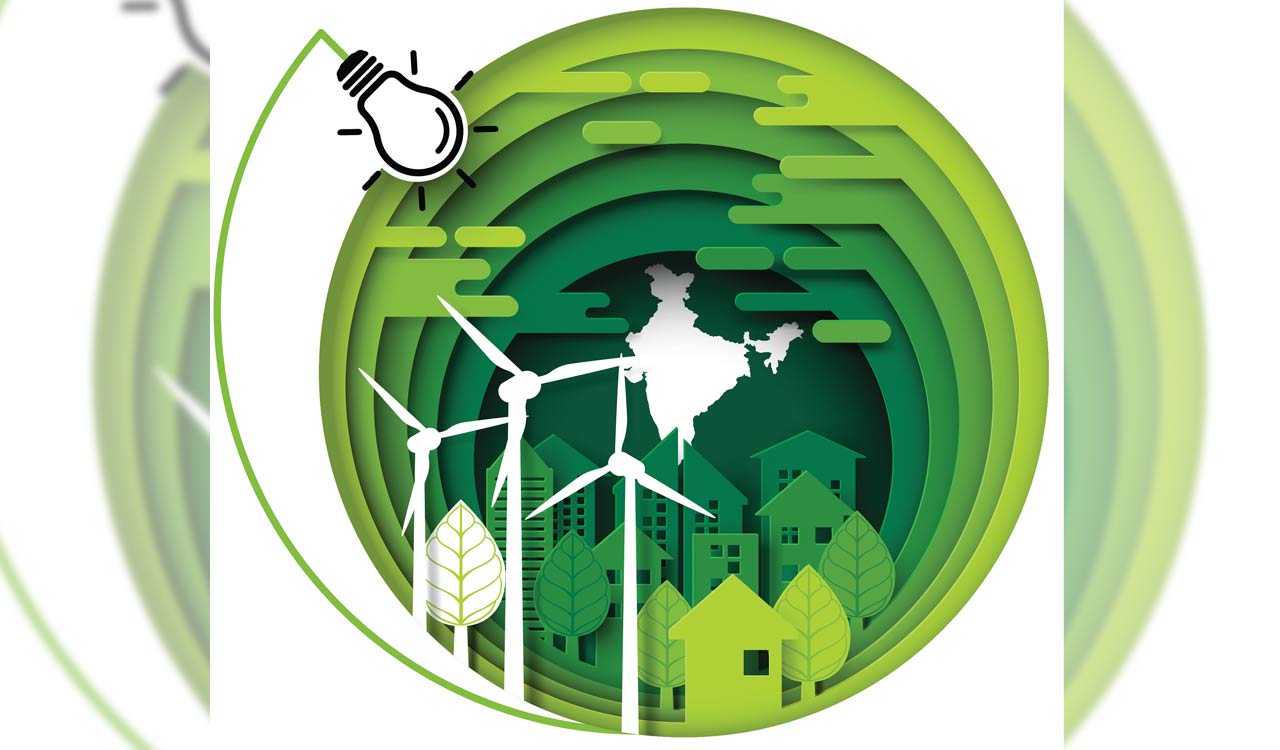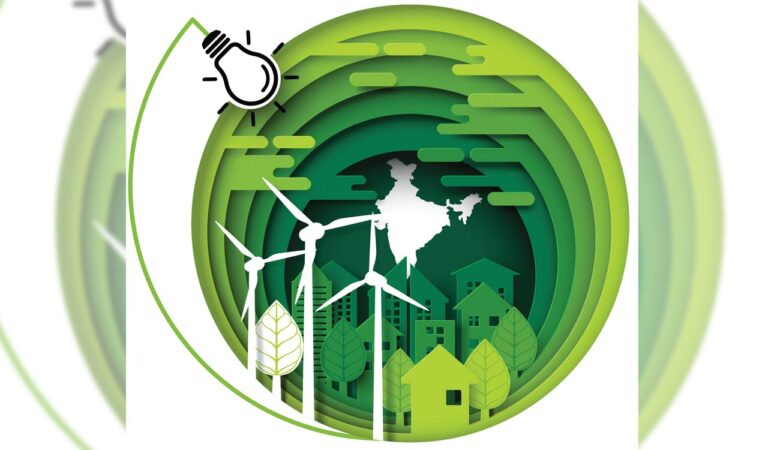India’s gold rush for sustainable energy will likely spark many debates, but emerging green will be a win for all.
Posted Date – 12:47 AM, Sun – 1/8/23

Illustration: Guru G.
Amit Mishra
Hyderabad: As India’s economy grows in size, the country’s renewable energy market presents an attractive opportunity for investors. India ranks third in the 2021 Renewable Energy Country Attractiveness Index (REN21’s Renewable Energy Global Status Report 2022). The industry has experienced significant growth with a CAGR of 16% between FY2016 and FY22.
India is expected to enjoy the fastest growth in renewable energy, quadrupling its capacity by 2026 as the world shifts to a more sustainable and greener future. Like the California Gold Rush of the 1850s, India’s renewable energy sector has seen a group of entrepreneurs, investors and industrialists eager to capitalize on the industry’s growth and potential.
And when the competition for the dominance of the green energy market is intensifying, can the big players in the country be willing to lag behind? It seems like Mukesh Ambani and Gautam Adani foresaw the viability of renewable energy years before anyone else and are now in a square circle , go head-to-head with each other for a chance. Otherwise, who would have thought that the renewable energy sector, which claims to be commercially advantageous, would eventually become profitable?
Reliance Industries, Adani Group, Tata Group and JSW plan to make a combined investment of approximately US$55 billion over the next 5-10 years. The companies are reportedly in various stages of negotiations to secure investment for their greenfield solar and wind projects, acquisitions and manufacturing facilities, and are also seeking strategic investments to meet their funding needs.
But why the sudden surge in investment in green energy by the bigwigs? Why are all the top corporate executives vying for their place in the nascent field? Does it promise returns beyond the comprehension of ordinary people? Let’s find out.
increasing investment
The nation’s energy consumption is expected to increase to 16,000 terawatt-hours by 2040, and renewable energy will play an important role in determining how to meet this demand. Additionally, the industry could see annual investment opportunities totaling more than $30 billion over the next decade and beyond. This would represent a huge and untapped investment potential three times higher than current levels.
India’s share of global primary energy demand is expected to double to around 11% by 2040. The country will need to expand its energy production by 2030, with nearly half of the new production coming from renewable sources, to meet this demand growth and keep it growing. It has pledged to reduce its carbon footprint by 35% from 2005 levels. According to the Economic Survey (2018-19), this would require the installation of 25 GW of renewable energy per year by 2030, which would cost an investment of around $250 billion from 2023 to 2030.
Over the past eight years, India’s renewable energy sector has attracted more than $70 billion in investment. Foreign direct investment (FDI) in the sector has grown steadily over the years, reaching $1.6 billion in 2021-2022, compared to $414.25 million in 2013-14. It is also worth noting that since 2013-2014 FDI in India’s coal sector has been virtually non-existent, indicating a strong preference for the renewable energy sector. Between 2014 and 2019, the industry spent a total of $64.4 billion on projects and programs, including $11.2 billion in one year (2019) alone.
private player
The country’s energy sector has traditionally relied on fossil fuels. However, due to the increasing scarcity of these resources, there has been a push towards renewable energy, especially since 2020. Private companies that previously relied on thermal energy are now taking the lead in building a green energy mix for the nation.
Private investment in India’s renewable energy market will increase significantly in 2021, reaching $18.8 billion. Local and international investment in the sector has grown by 40% since 2020. A large part of this investment has been used to create solar photovoltaic systems. Clearly, the need to switch to renewable energy is now more understood than ever.
The first to enter this field was Suzlon in 1995. Others have slowly but steadily sprung up, including Azure Power, Orb Energy, Tata Power Renewable Energy and ReNew Power. The combined market capitalization of all publicly traded renewable energy companies exceeds $40 billion and is expected to triple over the next five years.
The country has reached a point where every major company in India is venturing into green energy because of the promise of big payoffs since India reached net-zero emissions by 2070.
envy, jealousy, hate?
Join the link from where we started as two of India’s most successful business tycoons, Mukesh Ambani and Gautam Adani, will be in the country’s thriving renewable energy sector Start a grand showdown. This marks the first time their paths will intersect in the field. It’s sure to be a long game as these industry giants vie for dominance in the sustainable energy space. Both RIL and Adani Group have made ambitious commitments to clean energy, with Reliance planning to invest about $10 billion in the sector over the next three years, and Adani Group planning to invest about $70 billion over the next 15 to 20 years.
Both Reliance Industries and Adani Group are working on building a green hydrogen value chain. Reliance announced last year that it would build four gigafactories at the Dhirubhai Ambani Green Energy Giga Complex to produce solar panels, energy storage systems, electrolyzers and fuel cells. Last month, it increased plans to build a fifth Gigafactory on the same site. Reliance has made several acquisitions and acquired stakes in the renewable energy space. These companies include solar software maker Sensehawk, Sterling and Wilson Solar, Faradion Ltd and REC Solar.
The Adani Group is also quickly catching up. It unveiled plans to increase renewable energy production by 45 gigawatts for its Adani Green Energy unit and plans to produce 3 million tonnes of hydrogen per year by 2030, up from a previous target of 2.5 million tonnes. Adani New Energy, Adani’s new energy arm, also plans to produce 20 GW of renewable energy at its plant in Khavda, Gujarat.
India’s progress in meeting its green energy goals depends on the success of the two billionaires as they pivot their businesses to renewable energy and establish themselves as green energy tycoons.
However, the outcome of this game is not important, because this is not a zero-sum game. Through the renewable energy war, India will ultimately benefit from achieving net zero emission targets by 2070. India’s gold rush for sustainable energy will continue to spark a battle among billionaires for the lucrative market. Will this “green field” be a fair game, or will it turn into a two-team game, as it is now in the telecommunications space? It’s still too early!
go green
• Reliance Industries to invest approximately $10 billion in end-to-end solar power generation by 2024
• Tata Group plans to invest around US$10 billion over the next 5 years
• Adani Group commits more than US$15 billion over the next 10 years, aiming to become the world’s largest producer of renewable energy by 2030
• Aditya Birla Group and KP Group signed a US$30m deal in August to build a wind farm in Gujarat
• Greenko Energies and Hindalco Industries signed an agreement the same month to build 375-400 MW of solar and wind capacity, in addition to a renewable energy project that will provide 100 MW of continuous carbon-free electricity.The pledge supports Hindalco’s aim to become net carbon neutral by 2050
• JSW Energy about $10 billion; JSW Steel $1.3 billion
• The Ontario Teachers’ Pension Plan Board acquired a 30% stake in Mahindra’s Susten Private Limited for Rs 2,371 crore, enabling Susten to build a strong renewable energy business focused on solar, hybrid and integrated energy storage systems, and 24/7 Green Energy Plants
• In October, L&T announced plans to enter the green hydrogen market by building a plant at its Hazira complex, which is expected to be completed by this financial year. L&T to invest up to Rs 5,000 crore in green schemes over 10 years
• NTPC, BPCL and Indian Oil Corporation also plan to build green hydrogen installations
Game of Thrones
• India’s total installed capacity exceeds 400,000 MW, 40% of which comes from non-fossil fuel sources
• Aim to achieve net zero emissions by 2070
• 2030 targets include expanding renewable energy capacity to 500 GW, generating at least 50% of electricity from renewable sources, reducing cumulative emissions by 1 billion tonnes, and reducing the emissions intensity of GDP by 45%
• India will need 3.5 trillion units of electricity by 2036-37 to sustain a growth rate of 7.3% and 1.37 trillion units in 2021-2024
• National energy consumption projected to expand to 16,000 TWh by 2040
emphasize
On Wednesday, the Union Cabinet approved an initial expenditure of Rs 19,744 crore for the National Hydrogen Plan. The scheme aims to provide direct incentives for green hydrogen production, with an amount of about Rs 13,000 crore.
On Friday, the Reserve Bank of India announced the first auction of sovereign green bonds. These will be issued in two tranches of Rs 8,000 crore each, and the proceeds will be used to fund public sector projects seeking to reduce carbon emissions.
(The author is an academic assistant at the Indian School of Business).
